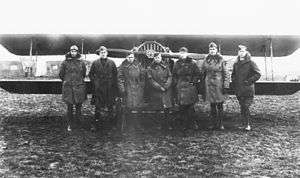Foucaucourt Aerodrome
| Foucaucourt Aerodrome | |
|---|---|
| Part of American Expeditionary Forces (AEF) | |
| Located near: Foucaucourt-sur-Thabas, France | |
|
SPAD XIII of the 213th Aero Squadron at Foucaucourt Aerodrome | |
 Foucaucourt Aerodrome | |
| Coordinates | 48°59′45″N 005°07′17″E / 48.99583°N 5.12139°E |
| Type | Combat Airfield |
| Site information | |
| Controlled by |
|
| Condition | Agricultural area |
| Site history | |
| Built | 1918 |
| In use | 1918–1919 |
| Battles/wars |
World War I |
| Garrison information | |
| Garrison |
V Corps Observation Group 3d Pursuit Group United States First Army Air Service |
- Please note there was another temporary WWI aerodrome called Foucaucourt at Foucaucourt-en-Santerre in the Somme department
Foucaucourt Aerodrome was a temporary World War I airfield in France. It was located 4.3 miles (6.9 km) ESE of Foucaucourt-sur-Thabas, in the Meuse department in Lorraine in north-eastern France.
Overview
The airfield was first built by the French in the summer of 1917, and turned over to the Air Service on 11 October 1917 as an observation airfield. Consisting of 89 acres, Air Service engineers constructed 12 wooden barracks and a mess hall on the site, as well as 5 buildings to be used as warehouses and maintenance shops. A station administration building and a hospital clinic was constructed along with an electrical and a telephone grid. The airfield had four French Bessonnenux aircraft hangars erected.[1]
The airfield was used as a primary operating base for the United States First Army Air Service. The mission of the base was battlefield reconnaissance over the V Corps area, providing aerial reconnaissance, written observations of enemy forces and performing artillery adjustments. Headquarters, V Corps Observation Group moved into the field in late September, along with the 99th and 104th Aero Squadrons (Observation), both equipped with Salmson 2A2 aircraft. Operations from Foucaucourt initially were preparations to help the V Corps in the Meuse-Argonne offensive. German soldiers opposed the attack from barbed-wire-protected trenches. Also, additional enemy pursuit, observation and bombardment forces meant most of the Kaiser’s best aviation units defended the area.[2]
When the ground attack began on 26 September, inclement weather restricted flight operations. Since cloud cover severely limited photographic reconnaissance, headquarters confined missions to a few, well-defined and extremely important areas. Aircraft and pilots often stood ready to fly, waiting in vain for any break in the clouds. When weather permitted, crews took oblique photographs along enemy lines. If the need for information was great, pilots flew even in heavy cloud cover hoping for a chance break to take that important picture.[2]
In early November, V Corps Observation Group moved up to Parois Airdrome, and the 3d Pursuit Group moved into Foucaucort from Lisle-en-Barrois Aerodrome with four SPAD XIII pursuit squadrons. The pursuit squadrons were also hampered by the bad weather, and concentrated their operations to below the clouds and to attacks on enemy infantry forces on the ground. These low-level attacks attacked enemy infantry forces along the sides of the roads east of the Meuse until the Armistice on 11 November.[2]
After the Armistice, the 3d Pursuit Group continued flying training sorties from Foucaucourt, remaining at the base until early February 1919 when the last unit (28th Aero Squadron) was ordered to report to the 1st Air Depot at Colombey-les-Belles Aerodrome to demobilize.[2] Foucaucourt was turned over to the 1st Air Depot for de-construction. All hangars and other structures were dismantled and all useful supplies and equipment were removed and sent back to the Depot for storage. Upon completion, the land turned over to the French government.[3]
Eventually the land was returned to agricultural use by the local farmers. Today, what was Foucaucourt Aerodrome is a series of cultivated fields located east of Foucaucourt-sur-Thabas. The airfield was located to the northeast of the Départmental 122/151 intersection (D122/D151), with no indications of its wartime use.
Known units assigned
- Headquarters, V Corps Observation Group, 20 September-4 November 1918
- 99th Aero Squadron (Observation), 20 September-4 November 1918
- 104th Aero Squadron (Observation), 20 September-4 November 1918[2]
- Headquarters, 3d Pursuit Group, 6–1 November 1918
- 28th Aero Squadron (Pursuit), 6 November 1918 – 15 February 1919
- 93d Aero Squadron (Pursuit), 6 November-15 December 1918
- 103d Aero Squadron (Pursuit), 6 November 1918 – 5 January 1918
- 213th Aero Squadron (Pursuit), 6 November-15 December 1918[2]
See also
References
![]() This article incorporates public domain material from the Air Force Historical Research Agency website http://www.afhra.af.mil/.
This article incorporates public domain material from the Air Force Historical Research Agency website http://www.afhra.af.mil/.
- ↑ Series L, Miscellaneous Sections of the Air Service, Volume 11, History of the Design and Projects Section of the Construction Division, Gorrell's History of the American Expeditionary Forces Air Service, 1917–1919, National Archives, Washington, D.C.
- 1 2 3 4 5 6 Series "D", Volume 2, Squadron histories,. Gorrell's History of the American Expeditionary Forces Air Service, 1917–1919, National Archives, Washington, D.C.
- ↑ Series 1, Paris Headquarters and Supply Section, Volume 30 History of the 1st Air Depot at Colombey-led-Belles, Gorrell's History of the American Expeditionary Forces Air Service, 1917–1919, National Archives, Washington, D.C.
